Making Kefir Fermented Milk from the original grains is easier than you think. The Health Benefits are numerous!
What is included in this article?
- This article addresses various questions about making Kefir, its benefits, and my personal experiences with making Kefir. Although it may be a lengthy article, it is well worth the read, and you can revisit it time and again to find the answers you need.
- How to make Kefir with Original Milk Kefir Grains
- Kefir-making supplies
- Difficulty level – Very Easy!
- Steps involved in fermenting Kefir
- What does it taste like?
- How to strain the mother grains and keep them going.
- What is Kefir Whey?
- How many calories are in Kefir?
- How to Save Kefir and Freeze It for Long-Term Storage.
- Health Benefits of Kefir, Scientific Studies.
- Kefir vs Creatine
- Sources and Research about Kefir.
- Don’t take my word for it; read the Cambridge University Study, which is available as a PDF at the link in the Health Benefit Sources and Related Content section at the bottom of the article.

Only a few supplies are needed to make your Kefir milk. Some Ball or Mason-style jars with plastic lids. A stainless steel strainer, a small spatula, a canning funnel, and a good-sized bowl or measuring cup. Of course, you can use leftover glass jars and cover them with a coffee filter; whatever you have is good. Kefir is easy to make, and the grains are resilient as long as you keep feeding them. If you need to stop for a while, you can freeze them for later.
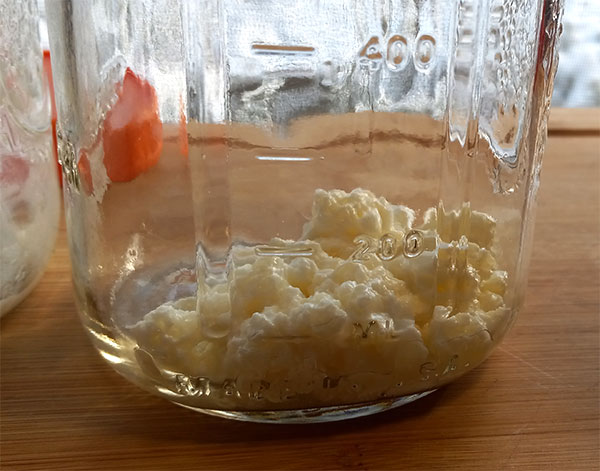
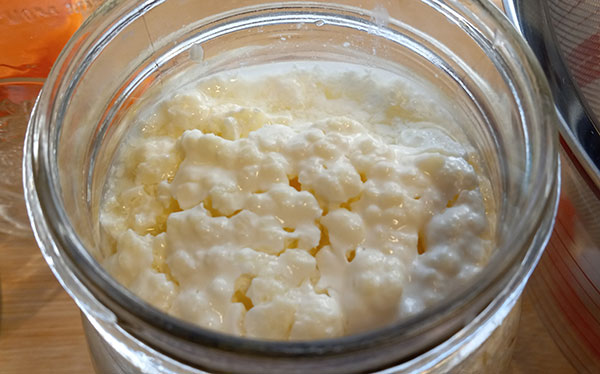
ready to strain out of the Kefir milk. Kefir grains (not like wholegrains) resemble small cauliflower heads and have a consistency similar to that of gummy bears. They don’t have any off-odor and are pleasantly tart-tasting.
How to Make Kefir from Milk Kefir Grains —an easy method to make smooth, thick Kefir milk.
- Place Kefir Milk Grains (Kefir water grains are different) in a 1-quart wide-mouth Ball or Mason-style Jar. (You can use other jars, I just like the wide-mouth jars.)
- Add 1 tablespoon Powdered Milk (helps make it thick and adds extra food for the Kefir Grains and additional protein for you).
- Add enough whole 3.5% *milk to fill almost the top of the jar (leave some breathing room) and stir gently. Cover loosely with a plastic lid and place on your kitchen counter away from direct sunlight. Kefir needs air to incubate; the loose lid lets in just enough without allowing foreign objects inside. (To store Kefir in the fridge, it is ok to use a regular Ball lid)
- Ferment for 24 hours at (68-72 ℉) (21-24°C). Usually, an out-of-the-way spot on your kitchen counter is perfect.
- Strain the Kefir Grains out of the Kefir Milk. Store the plain Kefir in the fridge and use it as you like. Repeat the process.
- For a Second Fermentation Period, after straining, add a small piece of fruit to the Kefir and let it ferment for a further period of time, from 2 to 24 hours. Refrigerate. The second fermentation gives a smooth taste and increases the nutritional profile.
- *You can use skim milk, but the butter fat helps make Kefir smoother.
What does it taste like?
Plain Kefir has a slightly tart, almost lemony taste. I find it quite delicious, and I like the taste better than plain yogurt. If it’s too sour for your taste, you can add a little honey, some fruit, or use it in a smoothie.
Kefir tastes best once it is chilled.
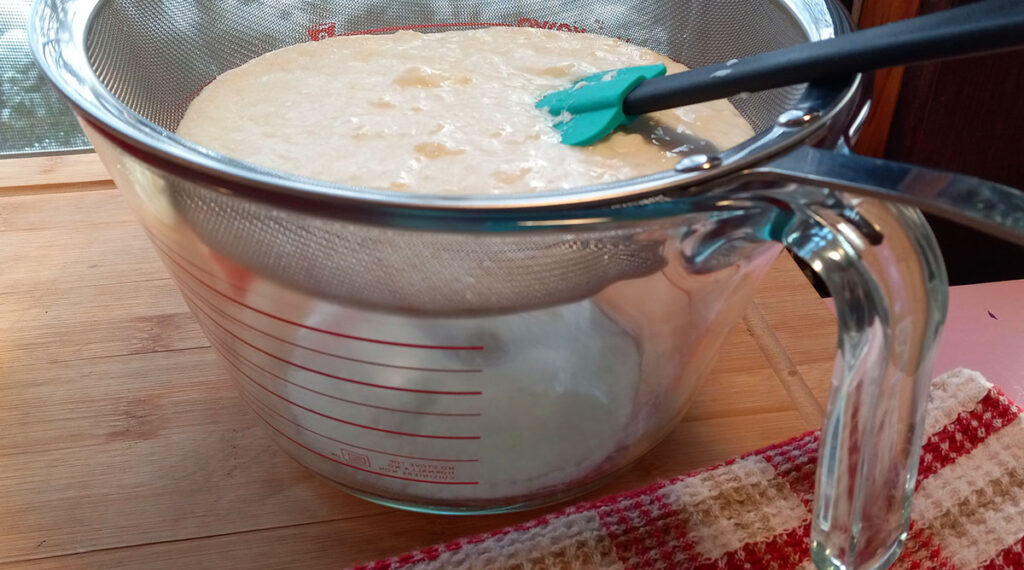
Gently stir the Kefir and Grains until the smooth, thick Kefir Milk has all been separated, and what remains are the Kefir Grains. Place the grains in a jar ready to start feeding them, and begin the process again. Kefir grains continue to grow, serving as the “Mother” of the Kefir.
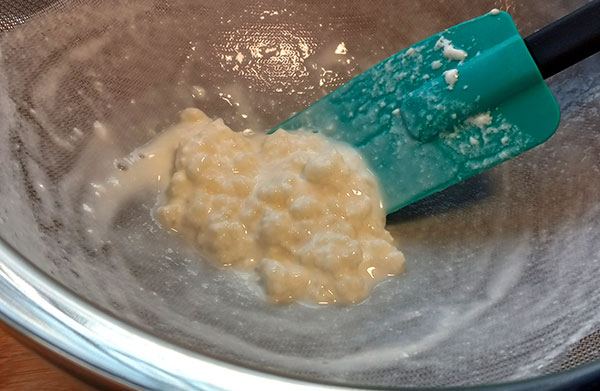
Small grains are “Baby Grains.” Sometimes, the grains can have some stringiness to them, but this is normal.
The Kefir with the grains becomes quite thick. The grains rise to the top with more liquid at the bottom. To make it easier to strain, start with the thick part and add the liquids gradually. Stir it all together at the end.
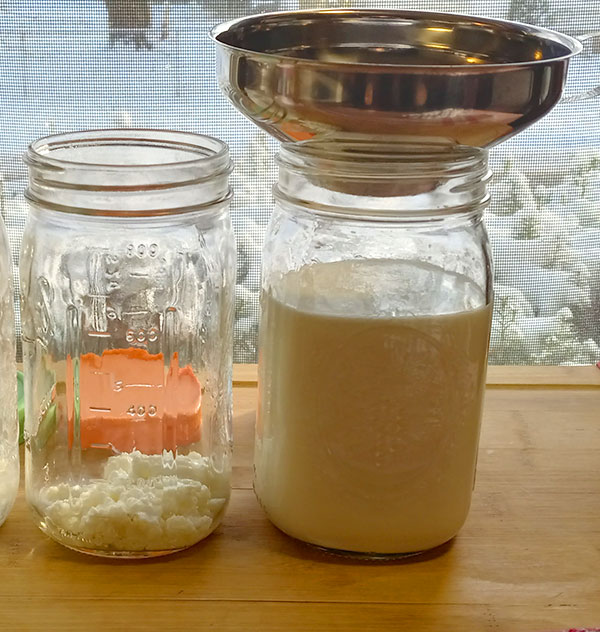
Once you become familiar with making Kefir, you will find your own ways to do it quickly. This process takes less than ten minutes of my morning. If you prefer to have it finished at another time, that is fine. I have found that 24 hours is just right, but it is not a terrible thing to let it go a bit longer. Some people do it for 48 hours.
How to Strain the Smooth Kefir Milk from the Grains
- Strain Kefir through a fine-mesh sieve made of plastic or stainless steel. Avoid using any metal other than stainless steel, as it can damage the grains. Try not to have Kefir sit in stainless steel for any length of time. During processing for brief periods, it is ok. Transfer to a glass and use plastic or silicone utensils. Avoid using a wooden spoon, as it is porous and may not be as clean.
- After pouring the Kefir and Grains into a sieve that is set on top of a glass bowl, use a small silicone or plastic spatula to gently stir the liquid, separating the grains from the liquid. Sometimes due to the Kefir becoming thick, I have a separate bowl to set the strainer in so I can add more of the liquids from the bottom of the jar for ease of separation.
- Don’t force the separation by pushing the grains through the sieve. Just be gentle.
- There is usually a small amount of Whey (clear liquid) that can be stirred into the Kefir without a problem. Refrigerate in glass jars with tight lids; either plastic or regular lids will be okay at this point.
- A Kefir Cage made of plastic with small holes in it is available to use to house your Kefir grains while they are fermenting. In this case, you remove the cage, store the Kefir Milk in the fridge, and start again by placing the cage in a clean bottle. I don’t have one of these. They are said to save time, but at some point, you have too many to fit in the cage. I like the straining method; it is fast, and getting all the grains out of the cage could be messy, too.
- Straining the Kefir Grains from the Kefir Milk using the sieve method only takes a few minutes.
- I usually start more each morning and strain the following day after breakfast while tidying up the kitchen. It adds just 10 minutes to my time.
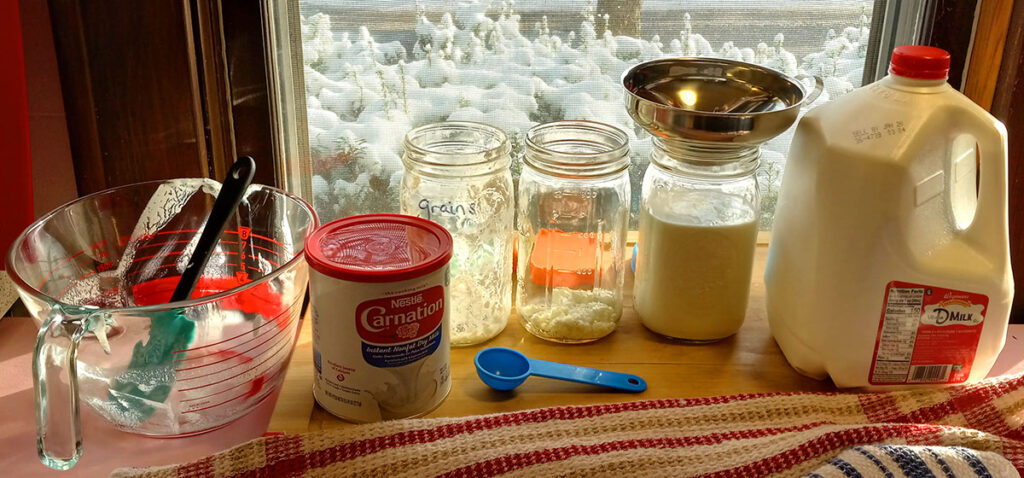
What is Whey, and how is it made?
Once the Grains have eaten or assimilated what they can from the milk, they begin separating Kefir milk into Clear Whey. This is a sign they need more food (add milk), or they have reached their optimum incubation period. Take this as a cue to strain the Grains from both the Kefir and the Whey. Feed the grains again and start fresh.
Whey is often used to make a lightly effervescent or fizzy summer drink with fruit. It is a delicious natural POP that is good for you. It contains many of the nutritious benefits that kefir milk has. Both are nutrient-dense whole foods. Keep it refrigerated.
How many calories are in Kefir milk?
One cup of whole milk Kefir is about 104 calories. The sugar content due to the fermentation process is 1 gram or less, depending on the duration of fermentation. Fermentation of milk with Kefir reduces the calories by just under 30%. When you use 10% cream to make the Kefir, it is more caloric, but delicious.
What is the optimum fertilization or incubation time for Kefir?
- The longer the Kefir Grains are allowed to ferment, the more acidic your Kefir will be and the lower its lactose content will be.
- 24 Hours of Fermentation is optimum, while the maximum is about 48 hours.
- The longer Kefir ferments, especially at a warm temperature, the more lactic acid is produced, causing a sour taste. The slightly tart and sour taste becomes something you love in time. You can add fruit, honey, or other natural sweeteners to the Kefir just before drinking it.
More Kefir-making details.
- While the beneficial bacteria in Kefir are generally well-controlled, an overly extended fermentation at a warm temperature can create an environment where other unwanted bacteria could begin to grow. You can always place it in the fridge for a day or two if needed.
- Kefir: Cover the Kefir loosely with a cap while it is fermenting. Kefir needs some air to ferment, and it also releases gas and expands slightly during the process. The grains also multiply and grow larger during the fermentation process. The grains congregate at the top partway during the fermentation, acting as a protective shield for the actual Kefir Milk and Whey.
- Kefir ferments via an Aerobic fermentation process. This means Kefir ferments in the presence of oxygen. Aerobic fermentation revolves around giving oxygen in exchange for carbon dioxide, resulting in the generation of heat by microbes and a consequent increase in temperature. Source: ScienceDirect.com
- Always keep implements, jars, and other items used in the making and storage of Kefir meticulously clean. There is no need to sterilize jars, but washing with plenty of soap and hot water is essential. Note: Let utensils and jars cool after cleaning to prevent overheating the grains and possibly damaging them inadvertently.
- You can use homogenized whole cow’s milk or even 2% milk; however, some advise against using ultra-pasteurized milk, as this process may interfere with the Kefir Grains’ ability to ferment. However, through my own experimentation, I found that ultra-pasteurized cream had no adverse effects. I believe that adding the powdered milk helps in this regard.
- Kefir Grains are resilient, but heat can kill them. At 120°F, they have most likely passed the point of no return.
- Kefir is delicious when made with raw milk, provided you have access to a farm and can obtain it. Sheep and goat milk is also good. Coconut milk is delicious; adding a little sugar can help facilitate fermentation. However, when I tried to make coconut kefir, it became too sour, and the thickness was not appealing. Perhaps someone else has a different result. Nut milk is also good.
- There is a Water Kefir type, but I don’t have experience with it as yet.
How much Kefir should you drink?
- On average, people drink one glass daily, but having more is acceptable. You suit yourself. Some drink a glass 3 times a day, while others use more depending on how they feel. Start slow and add more.
- It is my experience that drinking Kefir improves digestion and helps regulate the bowels. Kefir has many health benefits, and you can read more about them below.
Starting with new Kefir Grains for the first time.
- Your Kefir Grains may be a little inactive or tired due to transporting them to you. Here is how you can activate them again. Kefir is resilient, but improper handling can cause it to be no longer viable.
- Obtain fresh Milk Kefir grains (either through purchase or a gift from a friend) If Kefir grains have been frozen to mail you, they may take a few turns to become viable.
- Add 2.5 teaspoons of Kefir grains as a minimum to 4 cups of whole 3.5% milk (4 cups = 1 quart). More grains ferment more quickly. You can grow more grains to save and share.
- Optimum Fermentation or Incubation occurs at room temperature (68-72 ℉) (21-24°C) for 24 to 36 hours. It is ok to start with cold milk from the fridge and let it warm to room temperature.
Do you have to rinse Kefir Grains?
Many sources say to rinse your grains. However, this is not the case in most instances. As a rule, you don’t have to rinse Kefir Grains since they have a thick, nutrient-dense protective coating. If you need to rinse Kefir grains, it is best to use milk, but you can use cold water infrequently. If you are planning to make non-dairy milk Kefir, it is a good idea to rinse the grains in cool water before use.
If your Kefir grains have been frozen (this puts them to sleep) or mailed to you and unfrozen during transit, you may need to rinse them in milk and activate them by incubating them for more than 24 hours. Strain and discard the first and sometimes even the second batch of Kefir Milk. (so make a lesser amount the first couple of times)
How to Slow down Kefir Production or Save grains for an extended period.
You will find the proper schedule that suits your lifestyle so you do not run out of Kefir. If you find it fermenting faster than you need it, you can slow the process down by placing the grains in milk in the fridge for a day or two. (up to a week or two, as long as they have plenty of milk to feed on; this is where powdered milk can help you in a pinch if you run out of fresh). For longer periods, it is best to freeze the Kefir Grains. See below.
This is what works for me in my experience.
I use 2 Wide Mouth Ball Jars with plastic lids to make basic Kefir every 24 hours. I label the jars GRAINS so you don’t accidentally drink the grains. (Eating the grains is okay; you just don’t want to find that you have none left.) Not everyone likes to eat the grains; they are not totally unpalatable and have a mild chewy taste and consistency. It’s sort of like eating cottage cheese with a gummy bear consistency.
If we need less, I ferment only one jar with grains, place the second jar with grains and milk only half full, and place it in the fridge. Then, a day or two later, when we need more, I fill the second jar to almost the top and leave it to incubate for 24 hours at room temperature on my kitchen counter where there is little light.
How to Freeze Kefir Grains for Storage
You can freeze some Kefir Grains to store once you have enough to ensure you can begin again if your grains become dormant or contaminated. Freezing puts the grains to sleep.
Two Methods to Freeze Kefir Grains.
- Store in plastic freezer bags. Place strained and unrinsed Kefir Grains in either a small plastic freezer bag or in a glass jar.
- Once the grains are in the container, add some powdered milk and gently stir a little. Add fresh whole milk and stir. This serves to insulate the Kefir Grains, preventing freezer burn, and also provides the grains with food to awaken and feed them as they thaw.
- For instance, if you want to freeze 1/4 cup of Kefir grains, add 1 tbsp. Powdered milk and 1 cup of fresh whole milk in the container. Stir gently and freeze. As the grains thaw, they will feed on the milk. As soon as the grains are thawed, add more fresh milk.
- Wrap the plastic bags in another bag and seal them well.
- To freeze Kefir Grains in a glass jar. Add some powdered and fresh milk to the grains (in the same amount as above), then blend gently. Only fill the jar halfway so it will not break in the freezer as the milk expands. Once frozen, open the jar and pour in approximately half an inch of fresh milk. This provides a protective layer on top. Grains can be frozen for an extended period, but longer than six months may be suspect, although some report it was still good. I have had excellent results freezing Kefir grains for up to four months.
- To re-activate, thaw the Kefir Grains slowly in the fridge. When melted, place the Grains in a new, clean, and larger jar. Add more milk, let it ferment, and repeat the process. In my experience with thawing frozen grains to observe their effects, I found that they had a slightly astringent odor and taste, as opposed to fresh ones. Since this was unappealing, I strained the grains, added fresh milk, and started again. After two tries, the grains regained their natural appealing fragrance, taste, and appearance. The resulting Kefir from the frozen grains was again as it was before freezing.
How do you know the Kefir grains are good?
- Grains that appear a bit slimy at times are expected, and this is a good sign.
- Kefir Grains have no noticeable odor but a fresh, tangy scent similar to fresh yogurt. If it smells rotten, acrid, and sour, discard the Kefir.
- If the milk turns slightly sour during the incubation period, your grains are viable.
- Kefir Grains are little bits of cauliflower-like-looking gelatinous balls. The tiny ones are new and will grow in size over time. The larger ones increase the production of new “baby” grains.
- Kefir Grains, Kefir Milk, and Kefir Whey are all nutritious. Find ways to incorporate them into your diet. The grains are not as palatable to some people, but eating a spoonful is like eating jellied cottage cheese, like cottage cheese gummy bears.
- Kefir has a slightly sour taste. If it tastes spoiled, discard it. Kefir has very little smell at all. Originally, kefir was used to keep milk from spoiling. It will stay fresh in your fridge for two weeks or more.
- Kefir Grains are living organisms and must be fed to keep them alive. They feed on the lactose, casein, and sugars in milk. People who are lactose intolerant can often drink Kefir but not plain milk. Some casein is left and not assimilated by the grains, so each person needs to determine their own tolerance for Kefir.
Non-Dairy Kefir
Non-dairy kefir can be made using Nut Milk or Coconut Milk. Follow the same instructions and add. In this case, add a little sugar. (Raw sugar is best) To help make the Kefir creamier and thicker, you can use some coconut flour in the same way you would powdered milk. Or, in the case of nuts, use some ground almonds in the almond milk.
I recently made some coconut milk Kefir using tinned coconut milk, water, and coconut flour. The result was good, and it has a different sort of sweet and sour taste. Oddly, the kefir grains multiplied quite quickly over the two-week period I made it. I stored the mixture in the fridge for most of the two weeks and left it at room temperature for the last day. This was a kind of experiment, as the person I was making it for was away for the two weeks.
What Else Can You Make With Kefir?
When you have extra grains, you can add Kefir grains to 5% or 10% cream, half and half or 35% of the whipping cream to culture it. It can be more challenging to separate the grains from the cream. You can also use freshly fermented Kefir Milk, add it to the cream, and give it a second ferment.
Another way to make Cultured Cream
You can also add Kefir to other milk, cream, or butter to give it a cultured taste.
- Cultured Cream with Kefir Milk. Use about 1 tbsp. Kefir Milk per cup of cream.
- Make Cream Cheese by straining the Kefir Milk in a cheesecloth for a few hours to reach the consistency of cream cheese. Or use store-bought cream cheese, add some Kefir Milk, and blend. Let ferment for a couple of hours, then refrigerate.
- Make sour cream by adding strained milk (take some of the whey and liquid out to make it thick and creamy). Combine Kefir Milk (1/4 cup) and add it to the thick 35% Cream (2 cups)
How Nutritious is Kefir?

Kefir is Rich in Probiotics and other Nutrients
Kefir is a potent source of probiotics, which are beneficial bacteria that help maintain a healthy gut microbiome. It contains a more diverse range of probiotic strains compared to yogurt. Kefir is a microbial community of beneficial bacteria, yeasts, and nutrients. Kefir contains more probiotics in more significant amounts than any other single food. Probiotics can help improve digestion, boost the immune system, and reduce inflammation. Kefir is also known to protect against infections. Kefir is rich in protein, calcium, folic acid, and amino acids. The fermentation process also adds vitamins B1 and B12, phosphorus, riboflavin (B2), Vitamin K, and magnesium.
Counting the number of beneficial bacteria in Kefir is said to be akin to trying to count stars in the galaxy. However, according to a study from Cambridge University, Kefir contains at least 82 separate species, and a list of these can be found at the end of this article under the Health Benefit Sources and Related Content section.
Kefir vs Buttermilk
Kefir contains more live bacterial culture than Buttermilk since it is fermented from Kefir Grains. Buttermilk is a cultured milk product made as a byproduct of churning butter. Today, it is not the same as when butter was churned from raw milk. Buttermilk is a cultured dairy product made by adding lactic acid bacteria to low-fat or nonfat milk and allowing it to ferment. Sometimes, live bacteria can be added to a high-end buttermilk.
Bone Health:
- Kefir is a good source of calcium, essential for maintaining strong bones.
- Kefir also contains vitamin K2, which is crucial in metabolizing calcium and can help improve bone density.
Allergies and Asthma Symptoms:
- Kefir may help suppress inflammatory responses in the body, potentially alleviating symptoms of allergies and asthma.
Skin Health:
- “Homemade Kefir Consumption Improves Skin Condition-A Study Conducted in Healthy and Atopic Volunteers.”
- Kefir may help with skin hydration and the severity of atopic dermatitis (AD), a type of eczema.
- While many people with skin conditions, including eczema, are told to avoid dairy products and milk in particular, Kefir seems different in that the fermentation is almost a pre-digested form. Source: Healthline.
- Kefir contains metabolites and nutrients that may improve the skin barrier function.
- Some research suggests that skin conditions like eczema may be linked to GUT HEALTH. Probiotics can improve the gut microbiome, which may help with skin conditions.
- Kefir is a fermented food. Eating a variety of fermented foods like yogurt, sauerkraut, kimchee, and other fermented vegetables may help skin conditions as a benefit to added gut health.
- Inflammation is one of the significant causes of skin conditions, and increasing fiber intake helps feed healthy bacteria that produce short-chain fatty acids, which can alleviate inflammation.
New help for Eczema.
In listening to interviews of several doctors, it seems that eczema is a symptom of too much bad bacteria in the gut. For this reason, they recommended Kefir or Yogurt, fermented dairy products to add good bacteria to the gut. Good bacteria will overcome the bad over time. A little Kefir placed on the affected area for about 30 minutes and then rinsed off is also soothing. They suggested taking Kefir 3 or 4 times a day as a continual replenishment of good bacteria.
Another treatment was offered. A few drops of Black Current Seed Oil (Black Oil is not the same thing) are warmed up by rubbing them in the hands and then placed on the affected area to gently absorb it. Plus, take some Black Currant Seed Oil internally via capsules. The effective ingredient that helps is gamma-linolenic acid, and Black Currant Seed Oil has one of the highest concentrations of it, as well as Omega 3- 6- and 9. Video: A Functional Medicine Approach to Treating Eczema – The Gut Skin Connection. Consult your doctor, but they said this method is showing promising results.
Tallow is also suggested as a soothing ointment for eczema. You can melt Tallow (fat from beef that comes from the heart area and contains healthy nutrients) and some olive or other oil, such as Hohoba, plus a little glycerine together to make a salve.
Also, adding a small amount of apple cider vinegar to bathwater can be soothing. It was also suggested that limiting gluten in the diet can also help.
Improves Gut Health, Digestion, Blood pressure, and more.
- The probiotics in Kefir, along with added fiber, can help restore the balance of good gut bacteria, improving digestion and relieving issues like bloating, gas, constipation, or diarrhea.
- Gut Health: The fermentation process in Kefir creates a variety of bioactive peptides and other compounds that promote gut health. Kefir may have anti-cancer properties and may help prevent colon cancer due to its beneficial effects on the colon and gut health.
- Immune system: Kefir may help modulate the immune system and may help protect against viral infections.
- Blood pressure: Kefir may help lower blood pressure by inhibiting the angiotensin-converting enzyme (ACE).
- Anti-inflammatory: Kefir may help reduce inflammation by inhibiting neutrophil chemotaxis.
- Anti-microbial: Kefir may have anti-microbial properties.
Blood Sugar Control and Lower Bad Cholesterol:
- Some studies suggest Kefir may help improve blood sugar control in people with type 2 diabetes.
- Kefir may help reduce fasting blood sugar levels and improve insulin sensitivity.
- Since blood sugar control is a good preventative measure for excess weight gain, Kefir may help in this area.
- Kefir use may help reduce total cholesterol and LDL (bad) cholesterol levels.
It’s important to note that while kefir offers numerous potential health benefits, individual responses may vary. It’s always best to consult a healthcare professional before making significant dietary changes if you have any specific health concerns.
Possible Hormonal Changes
Some individuals might experience temporary hormonal fluctuations or sensitivity after consuming kefir, which could manifest as hot flashes or other related symptoms. This can be a good thing if you have a hormonal imbalance you are not aware of. Because kefir is rich in probiotics and beneficial bacteria that positively impact gut health, it can also help maintain a positive hormonal balance.
A side effect of increasing your probiotic intake can result in what is called a Die-off of harmful bacteria. From personal experience, I have found positive benefits from consuming Kefir daily for the first several months. However, sometimes the Die-off effect can feel like you are getting a cold or flu for a day or two, and then subside with no cold or flu having developed.
When we have a bodily issue we may be dealing with, in general, a pill is prescribed. We expect fast results, but with the elimination of the pills, the benefits sometimes go away. Or there are side effects to particular medications we don’t want to risk exposing ourselves to. Nutritious foods like Kefir are not an instant solution; however, in the long term, they can be healthier when a situation allows. Of course, medications can be life-saving when prescribed by a professional.
Increased Nutrients in the Second-Fermented Kefir
When you add a small amount of fruit to Kefir and ferment it for the second time, this results in an increase of certain nutrients and can offer additional benefits.
- Vitamins: The most significant increase is often seen in B vitamins, particularly folate (B9). The fermentation process, fueled by the sugars in the fruit, allows the Kefir’s microorganisms to produce more of these vitamins. Additionally, the fruit itself contributes its own vitamins. For instance, adding oranges will boost vitamin C content, while blueberries provide more vitamin K.
- I recently added half a Madjool Date and fermented the Kefir for an additional 24 hours at room temperature. I couldn’t tell you what nutrients this increased, but since dates are nutritious, I can guess there was an increase. The resulting Kefir Milk was very smooth and delicious.
- Minerals: The mineral content will not drastically change during the second fermentation. It may enhance the bioavailability of certain minerals like calcium and magnesium so that your body absorbs these more readily.
- Prebiotics: The attributes of non-digestible fiber in most fruits are that they are a good source of prebiotics; they act as food for the probiotic bacteria in Kefir. The sugars and fibers in the fruits add a different food source for the Kefir, which increases the beneficial bacteria, etc.
- During the process of Kefir fermentation, a very small amount of alcohol is created, which can be enough to give sensitive people an effervescent buzz, but I have never heard of anyone getting drunk on it.
Other Benefits of Second Fermentation:
- A smoother and increased flavor: The second fermentation process consumes more of the remaining lactose (milk sugar), which reduces the tartness of the kefir.
- Increased Probiotics: While kefir is already rich in probiotics, the second fermentation can further enhance their numbers as the bacteria continue to thrive and multiply.
- Reduced Lactose: As mentioned earlier, the second fermentation can further reduce the lactose content, making it more suitable for people with lactose intolerance.
Overall, second fermentation with fruit can be a great way to enhance the nutritional value and palatability of your homemade kefir. It’s a straightforward process that offers a range of benefits, including increased vitamin content and improved mineral bioavailability, as well as a more flavorful and somewhat effervescent beverage.
Longevity and Kefir Consumption.
The people of the Caucasus region in Russia are among those who live the longest in the world. The reason they live as long as they do is still a mystery, but it is well-known that Kefir is a staple food in the region.
“The Russian immunologist Dr. Ilya Ilyich Metchnikoff (who received the Nobel Prize for his work on immunity in 1908) became interested in learning about the causes of the exceptional longevity of the people in the Caucasus region and other regions. Metchnikoff came to the conclusion that soured milk, including milk kefir, was one of the keys to longevity and well-being. Following the publication of Metchnikoff’s book, The Prolongation of Life, in 1907, the All Russian Physicians’ Society became determined to use milk kefir as a medicinal treatment for their patients.
The Blandov brothers, from Moscow Dairy, were commissioned by the All Russian Physicians’ Society to obtain kefir grains from the tribes in the Caucasus mountains. However, the tribes refused to sell any kefir grains to the Blandov brothers. Undaunted, the brothers came up with a scheme to obtain the kefir grains: they would send a beautiful woman to the court of tribal Prince Bek-Mirza Barchorov, and with her allure she would obtain the kefir grains. Irina Sakharova, an employee of the Blandov brothers, was chosen for this important mission.”
Pronunciation
People pronounce Kefir in various ways; however, according to the dictionary, Kefir is a noun pronounced with a soft E and a hard I. (kĕ-fîr′). Further, according to the dictionary, the name Kefir is most likely originally -[Russian, probably ultimately from Old Turkic köpür, (milk) froth, foam, from köpürmäk to froth, foam.] A type of Kefir has existed in ancient cultures for almost 3000 years.
Kefir vs Creatine
What is Creatine?
According to the Mayo Clinic, Creatine supplement powder, “…is a compound that comes from three amino acids. Creatine is found mostly in your body’s muscles as well as in the brain.” Simply put, Creatine is touted as a new high-profile supplement, and many people use it as a restorative in high-intensity exercise.
“Creatine is a molecule primarily composed of the amino acids glycine, arginine, and methionine. It is synthesized in the body and is also found in certain foods. In muscles, it’s often present as phosphocreatine, which plays a role in energy production during high-intensity exercise.”
How does Kefir Compare with Creatine?
Kefir contains the amino acids glycine, arginine, and methionine, among others. Kefir is a fermented dairy product that, like other dairy products, provides a good source of protein and essential amino acids.
“According to Liutkevičius & Šarkinas(31), the essential amino acid contents in kefir are in descending order: lysine (376mg/ 100 g); isoleucine (262 mg/100 g); phenylalanine (231 mg/ 100 g); valine (220 mg/100 g); threonine (183 mg/100 g); methionine (137 mg/100 g); and tryptophan (70 mg/100 g). Source: Lietuvos Veterinarijos Akademija, ISSN (Print): 1392-2130, CABI Record Number: 20043068120; Kaunas, Lithuania.
More about the Amino Acids in Kefir and how they affect the body.
- Glycine: Kefir contains glycine, listed as a non-essential amino acid involved in various bodily functions, including protein synthesis and collagen production.
- Arginine: Kefir is also a source of arginine, an essential amino acid that is beneficial for both children and adults. It is involved in the synthesis of creatine, a compound necessary for muscle energy, and plays a role in nitric oxide production, which helps regulate blood flow.
- Methionine: Kefir contains methionine, an essential amino acid that is part of the sulfur-containing amino acid group. It plays a role in protein synthesis and the body’s detoxification process.
- Isoleucine: Kefir contains the essential amino acid Isoleucine, which is involved with muscle metabolism and immune function. It also helps your body make hemoglobin and regulate energy.
- Leucine: Kefir contains the essential amino acid leucine, which the body uses to produce protein and growth hormones. It also helps grow and repair muscle tissue, heal wounds, and regulate blood sugar levels.
- Lysine: An essential amino acid contained in Kefir is Lysine, which is considered a building block of protein. Lysine is essential for proper growth and plays a crucial role in the production of carnitine. This nutrient facilitates the conversion of fatty acids into energy and helps lower cholesterol levels.
- Tryptophan: Kefir also contains Tryptophan, an essential amino acid that the body uses to help make melatonin and serotonin. Melatonin helps regulate the sleep-wake cycle, and serotonin is believed to play a role in regulating appetite, sleep, mood, and pain.
Health Benefit Sources and Related Content.
- The Cambridge University Study on Kefir. Worth the time to read it all. (Also contains a good review of the efficacy of Kefir on Eczema, which is encouraging for those who suffer from this.)
- [1] Zeynep B. Guzel-Seydim, Tugba Kok-Tas, Annel K. Greene & Atif C. Seydim. “Review: Functional Properties of Kefir.” Critical Reviews in Food Science and Nutrition, 51:3, 261-268, 2011. doi: 10.1080/10408390903579029
- [2] Bourrie, Benjamin C T, et al. “The Microbiota and Health Promoting Characteristics of the Fermented Beverage Kefir.” Frontiers in microbiology vol. 7 647, 2016. doi:10.3389/fmicb.2016.00647
- [3] de Oliveira Leite, Analy Machado, et al. “Microbiological, technological and therapeutic properties of kefir: a natural probiotic beverage.” Brazilian Journal of Microbiology: [publication of the Brazilian Society for Microbiology] vol. 44,2 341-9, 2013. doi:10.1590/S1517-83822013000200001
- [4] “Fermented milk products,” Wikipedia, Wikimedia Foundation, August 11, 2020. https://en.wikipedia.org/wiki/Fermented_milk_products
- [5] Shavit, E. “Renewed Interest in Kefir, the Ancient Elixir of Longevity.” Fungi, vol. 1-2, 2008. http://www.medicinabiomolecular.com.br/biblioteca/pdfs/Doencas/do-1175.pdf
- [6] Seifi, P. “Magical Kefir.” Russian Life website, 2016. https://russianlife.com/stories/online/magical-kefir/
- [7] Nielsen B, Gürakan GC, Unlü G. “Kefir: a multifaceted fermented dairy product.” Probiotics Antimicrob Proteins 6:123–135, 2014. https://pubmed.ncbi.nlm.nih.gov/25261107/
Kefir contains at least 82 separate species according to an updated study by Cambridge University.
- Lactobacilli
- Lactobacillus acidophilus
- Lactobacillus brevis
- Lactobacillus bulgaricus
- Lactobacillus casei
- Lactobacillus crispatus
- Lactobacillus delbrueckii subsp. Bulgaricus
- Lactobacillus delbrueckii subsp. lactis
- Lactobacillus fermentum
- Lactobacillus fructivorans
- Lactobacillus galinarum
- Lactobacillus gasseri
- Lactobacillus helveticus
- Lactobacillus hilgardii
- Lactobacillus kefir
- Lactobacillus kefiranofaciens subsp. kefiranofaciens
- Lactobacillus kefirgranum
- Lactobacillus mesnterioides
- Lactobacillus paracasei
- Lactobacillus parakefiri
- Lactobacillus plantarum
- Lactobacillus reuteri
- Lactobacillus rhamnosus
- Lactobacillus viridenscens
Lactococci - Lactococcus lactis subsp. lactis
- Lactococcus lactis subsp. cremoris
- Lactococcus lactis subsp. Lactis biovar diacetylactis
*Streptococci - Streptococcus cremoris
- Streptococcus durans
- Streptococcus faecalis
- Streptococcus thermophilus
*Acetic acid bacteria - Acetobacter aceti
- Acetobacter lovaniensis
- Acetobacter syzgii
- Acetobacter pasteurianus
- Gluconobacter oxydans
*Other bacteria - Bacillus sp.
- Bifodobacterium bifidum
- Enterococcus durans
- Escherichia coli
- Micrococcus sp.
- Leuconostoc mesenteroides
- Leuconostoc citreum
- Pediococcus acidilactici
- Pediococcusdextrinicus
- Pediococcus pentosaceus
*Yeasts - Brettanomyces anomalus
- Candida albicans
- Candida friedricchi
- Candida lipolytica
- Candida holmii
- Candida inconsipicua
- Candida kefir
- Candida krusei
- Candida lambica
- Candida maris
- Candida pseudotropicalis
- Candida tannoterlerans
- Candida tenuis
- Candida valida
- Cryuptococcus humicolus
- Debaryomyces hansenii
- Issatchenkia occidientalis
- Kazachstania aerobia
- Kluyveromyces lactis
- Kluyveromyces maxianus
- Kluyveromyces lactis
- Lachancea meyersii
- Pichia fermentas
- Saccharomyces cerevisiae
- Saccharomyces delbruecki
- Saccharomyces exiguus
- Saccharomyces fragilis
- Saccharomyces humaticus
- Saccharomyces lactis
- Saccharomyces lipolytic
- Saccharomyces turicensis
- Saccharomyces unisporus
- Torulopsis holmii
- Torulospora delbruechii
- Zygosaccharomyces sp.
- Weissella
- Yarrownia lipolytica
Transcribed above for those of us who want to know as much as possible about how Kefir will affect our health.
Please note: The author of this article is not a health professional. Any information has been gained via personal experience and research. Every person’s health is unique, and you should consult your healthcare professional for advice before adding Kefir to your diet.





Pingback: How To Save Money On A Gluten-Free Diet – Gluten-Free Trina
Pingback: Making Kefir Cream – Gluten-Free Trina
Pingback: Taking Care Of Yourself – Astoria Magazine
Pingback: Rethinking Mental Health – Astoria Magazine